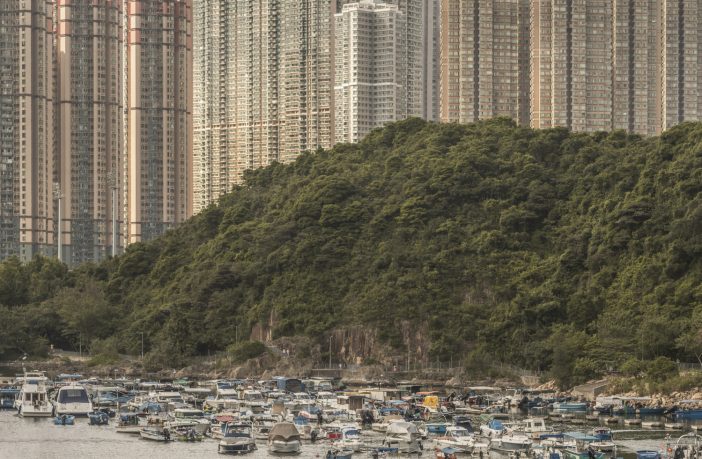- In the introduction of Cities for People, Jan Gehl stated clearly that most cities have neglected the human aspect when planning the built space.
- While technologies have allowed us to build large, our focus shifted from creating architecture for humans to erecting structures that look like they are meant for a different kind of species.
- Top-down urban planning decisions have ignored scales adapted to the senses and organic growth, and new ideologies prioritized speed, functionality, and profitability.
Dictating our city experience, scale, this major spatial component related to the human dimension, stimulates our senses, and influences our well-being. In this article, we lay down historical changes and underline scientific facts to highlight how scale can impact our daily city life, guided by Eden of the Orient, a series of photos by Belgian photographer Kris Provoost, portraying a battle of scale in Hong Kong.
In Eden of the Orient, Kris Provoost has captured the urban dilemma faced by Hong Kong. Known to be a vertical city with the highest number of skyscrapers in any city around the world, Hong Kong has been building hyper-dense “new towns”, ever since the 1950s, to solve housing shortage, cost of land and to accommodate its ever-rising population. These new overwhelming and massive housing estates, rising up to 70 floors, are built on reclaimed lands, a set of islands, with mountainous terrain. Intruding on nature, the images highlight an impressive battle of scale, between the high rise living and the abundant green-topped mountains. Raising the problem of future livability of these areas, the series of images showcases the absence of the human dimension.
Questioning the relation between the livability of space and the scale of the surrounding built environment, we examined the facts that led to this global reality, and drew concrete conclusions, founding our reflections on Cities for People, by Jan Gehl.

In the 1920s, new modernist ideologies introduced urban developments that praised huge distances, tall buildings, and fast architecture. As new technologies took over, comfortable proportions were vanishing progressively. New scales emerged with no regard to traditional knowledge. Everything became bigger, and construction became faster. Huge built-up areas created cold, impersonal, and formal environments. Cities were a collection of stand-alone constructions and large roads. Due to a lack of understanding of the human scale, we ended up with cities with large buildings for small people. Taking a couple of decades before realizing the consequences, it was only in the 1960s that Jane Jacobs raised the flag and claimed in her book The Death and Life of Great American Cities, that this urban planning ideology that produced free-standing individual buildings would put an end to urban space and city life. People were finally re-questioning their built environment.

As people understood the value of the human scale when creating cities, they first had to reflect on the human body. Humans who have a horizontal sense of sight, allowing them to walk straight do not see much above them. While low buildings keep up with our “horizontal sensory apparatus”, high buildings do not. In fact, our angle of vision is limited to 50-55 degrees above the horizon, making it difficult to raise our heads. Impacting our understanding of the space that surrounds us, these sensors make it easier to experience low-rise structures. In his book Cities for People, Jan Gehl states that “from the street, we can only experience with difficulty events that take place higher up in buildings. The higher up, the more difficult it is to see. […] the connection between street plane and tall buildings is effectively lost after the fifth floor […] they no longer belong to the city”. In fact, it is very easy for tall buildings to be disconnected from the context and not take part in city life.

Defining different experiences, smaller scales, in harmony with the human scale produce communication, warmth, closeness, and even contact in an urban environment. Influencing our senses of being in the space, it is easier for us to be around low-rise buildings. “The experience of comfort and wellbeing in cities is closely tied to how city structure and city space harmonize with the human body, human senses, and corresponding space dimensions and scale”. Basically, our experience is largely determined by the scale of everything that surrounds us. Whether we feel like lingering in a space, moving around, or taking off, our behavior is directly related to the spatial proportions of our context. The more natural and unforced the experience is, the more we want to stay in the environment.

That being said, only building low-rises is also not an optimal solution especially when cities are facing challenges like urban sprawl and housing crisis related to the growing population. Cities need high building density, but neglecting the human scale is never an option. For that, modern urban planningpraises a combination of inviting city space, modest dimensions, and a clear hierarchy in the built environment. In order not to shatter the human scale, “the principle should be to build cities that are attractive and cohesive at eye level and put larger buildings on top”, according to Jan Gehl. An ideal situation would involve therefore different scales. As most of our cities are largely built and the big bulk of large scale projects are already in place, the only way to have an impact and fix what has already been done, is through intervention on the quality of the human landscape, reducing visual dimensions, and establishing approachable spaces.
Author: Christele Harrouk
This article was first published in Arch Daily and is republished with permission.















